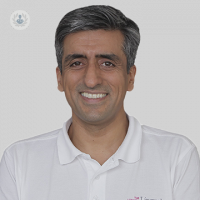A (bite-sized) summary of malocclusion
Written by:Though more and more of us are now concerned about the appearance of our teeth, our bite is not something that we give much thought to. It’s just there, working every day, enabling us to eat and to speak. We may not perceive it to be a priority but the bite is essential to everyday wellbeing and we interfere with it at our peril. Dr Asif Chatoo is an orthodontist from London and founder of the Lingual Orthodontic Clinic. In this article, he provides you with a comprehensive summary of malocclusion, why it should be addressed and it's treatment.

What is a malocclusion?
Occlusion is a term that that refers to how we bite and the way the upper and lower teeth meet and interact, both at rest and at work (when we are eating). In an ideal situation, the teeth of the lower jaw sit inside the teeth of the upper jaw so that the upper teeth slightly overlap the lower teeth. The pointed ridges of the lower premolar and molar teeth fit into the grooves of the opposite upper teeth. Any deviation from this ideal is known as a malocclusion. This term comes from Latin and means bad bite.
Perfect bites are rare. This means that when someone has orthodontic treatment to have their teeth straightened, the bite needs to be considered too. There is no point in aligning the teeth without giving thought to how the upper and lower teeth meet. It is usually possible to improve both the smile and the bite and the bite should always be a consideration in any treatment plan.
Why should the bite be of concern?
A dysfunctional bite, referred to by orthodontists as a malocclusion, is more common than you think. Many children and adults have upper and lower teeth that do not fit together perfectly. Over time, if teeth do not meet and function normally, the following can occur:
- The teeth wear down prematurely
- Pain and sensitivity of the teeth
- Gum problems
- Jaw joint problems
A small proportion of the population has a severe malocclusion that can make it difficult to eat or speak. When this occurs in a growing child or a young teenager, they may benefit from a functional appliance. In adults, it’s more difficult to correct a severe malocclusion and in these instances, it may be necessary to have orthognathic surgery. This involves surgery to correct the relative position of the upper and lower jaw to create an ideal bite. Treatment involves the orthodontist working with a maxillofacial surgeon. For more information, you can visit the British Orthodontic Society’s website.
How do you fix a malocclusion?
Orthodontic treatment is essentially the treatment of malocclusion. It involves straightening the teeth and improving the bite. The treatment may be achieved with fixed or removable braces.
Fixed braces provide 3D movement of the teeth and allow greater control of the bite between the upper and lower teeth. The braces (conventional metal or clear braces) may be placed on the outer or inner (lingual) surfaces of the teeth.
The use of intraoral scanners, photographs and X-rays allow accurate simulation of the effects of orthodontic treatment. Using 3D technology, such as SureSmile Advanced, the orthodontist can order custom made wires so that treatment is unique and modelled to your specific requirements.
Where can I get help?
If you are an adult considering teeth-straightening, you will have many questions. It’s impossible to say which treatment or approach is best without a consultation with your orthodontist. For instance, the questions you might ask are:
- How long will treatment take?
- Is it possible to have invisible orthodontics?
- Can Invisalign be my treatment of choice?
We need to see you before we can answer those questions. If you are making important decisions in the coming year about orthodontic treatment, don’t overlook the bite. As we age, having a comfortable and functional bite is invaluable.
As Dr Chatoo says, a comfortable and functional bite is invaluable. Get yours checked by booking a consultation via his profile.



